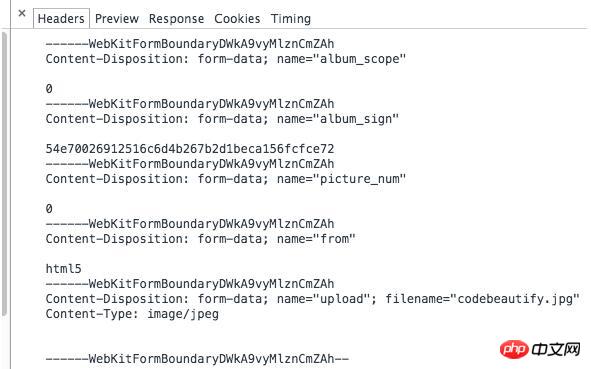
Below I will share with you an example of file upload using Node layer simulation to implement multipart forms. It has a good reference value and I hope it will be helpful to everyone.
Sometimes there is such a demand. Nodejs is used as a webserver to upload files from the browser to the back-end server. The Node layer only does a data transfer. If in this process, the Node webserver needs to properly process the data. Processing, and then Posting to the backend, then you have to simulate file upload at the Node layer.
First, upload the file through the browser. The PostData format looks like this:

Screenshot 2014 -11-22 PM 9.18.45.png
As shown in the picture, each set of data is actually separated by "-----WebkitFormBoundary....", and finally used This delimiter ends, and this delimiter is completely customizable.
Each piece of submitted data is described by Content-Disposition. If Content-Type is not specified, the default is text/plain. If it is an uploaded binary file, just specify its mime-type.
Simply encapsulate a method to implement file upload at the Node layer:
/** * 上传文件 * @param files 经过formidable处理过的文件 * @param req httpRequest对象 * @param postData 额外提交的数据 */ function uploadFile(files, req, postData) { var boundaryKey = Math.random().toString(16); var endData = '\r\n----' + boundaryKey + '--'; var filesLength = 0, content; // 初始数据,把post过来的数据都携带上去 content = (function (obj) { var rslt = []; Object.keys(obj).forEach(function (key) { arr = ['\r\n----' + boundaryKey + '\r\n']; arr.push('Content-Disposition: form-data; name="' + key + '"\r\n\r\n'); arr.push(obj[key]); rslt.push(arr.join('')); }); return rslt.join(''); })(postData); // 组装数据 Object.keys(files).forEach(function (key) { if (!files.hasOwnProperty(key)) { delete files.key; return; } content += '\r\n----' + boundaryKey + '\r\n' + 'Content-Type: application/octet-stream\r\n' + 'Content-Disposition: form-data; name="' + key + '"; ' + 'filename="' + files[key].name + '"; \r\n' + 'Content-Transfer-Encoding: binary\r\n\r\n'; files[key].contentBinary = new Buffer(content, 'utf-8'); filesLength += files[key].contentBinary.length + fs.statSync(files[key].path).size; }); req.setHeader('Content-Type', 'multipart/form-data; boundary=--' + boundaryKey); req.setHeader('Content-Length', filesLength + Buffer.byteLength(endData)); // 执行上传 var allFiles = Object.keys(files); var fileNum = allFiles.length; var uploadedCount = 0; allFiles.forEach(function (key) { req.write(files[key].contentBinary); var fileStream = fs.createReadStream(files[key].path, {bufferSize: 4 * 1024}); fileStream.on('end', function () { // 上传成功一个文件之后,把临时文件删了 fs.unlink(files[key].path); uploadedCount++; if (uploadedCount == fileNum) { // 如果已经是最后一个文件,那就正常结束 req.end(endData); } }); fileStream.pipe(req, {end: false}); }); }
The idea is like this, the code is not complicated, and you may need to pay extra attention The thing is, in the response processing of http.request, the response.headers may be gzip. At this time, the buffer cannot be directly toString. It needs to be decoded by zlib and then converted to string. The general idea is:
var result = []; response.on('data', function (chunk) { result.push(chunk); }); // 处理response var _dealResponse = function (data) { var buffer = data; try { data = data.toString('utf8'); data = data ? (JSON.parse(data) || data) : false; } catch (err) { // 接口返回数据格式异常,解析失败 console.log(err); } self.res.writeHead(response.statusCode, 'OK', { 'content-type': 'text/plain; charset=utf-8', 'content-length': buffer.length }); self.res.write(buffer); self.res.end(); }; response.on('end', function () { result = Buffer.concat(result); // gzip 的数据,需要zlib解码 if (response.headers['content-encoding'] == 'gzip') { zlib.gunzip(result, function (err, dezipped) { var data = err ? new Buffer('{}') : dezipped; _dealResponse(data); }); } else { _dealResponse(result); } });
Mark it, maybe You just need it when you pass by~~~
The above is what I compiled for everyone. I hope it will be helpful to everyone in the future.
Related articles:
Gzip compression issues in HTTP
##How to write a Snake game using JS code (detailed tutorial)
How to convert path to base64 encoding in Javascript
The above is the detailed content of How to implement multipart form file upload using Node layer. For more information, please follow other related articles on the PHP Chinese website!




